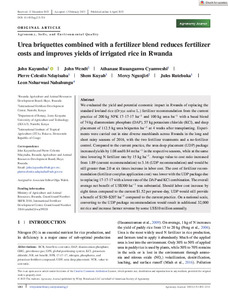| dc.contributor.author | Kayumba, J. |
| dc.contributor.author | Wendt, J. |
| dc.contributor.author | Cyamweshi, A.R. |
| dc.contributor.author | Ndayisaba, P.C. |
| dc.contributor.author | Kuyah, S. |
| dc.contributor.author | Ngunjiri, M. |
| dc.contributor.author | Rutebuka, J. |
| dc.contributor.author | Nabahungu, L.N. |
| dc.date.accessioned | 2024-03-13T09:07:16Z |
| dc.date.available | 2024-03-13T09:07:16Z |
| dc.date.issued | 2023-04-06 |
| dc.identifier.citation | Kayumba, J., Wendt, J., Cyamweshi, A. R., Ndayisaba, P. C., Kuyah, S., Ngunjiri, M., ... & Nabahungu, L. N. (2023). Urea briquettes combined with a fertilizer blend reduces fertilizer costs and improves yields of irrigated rice in Rwanda. Agronomy Journal, 115 (3), 1202-1213. |
| dc.identifier.issn | 0002-1962 |
| dc.identifier.uri | https://hdl.handle.net/20.500.12478/8431 |
| dc.description.abstract | We evaluated the yield and potential economic impact in Rwanda of replacing the standard lowland rice (Oryza sativa L.) fertilizer recommendation from the current practice of 200 kg NPK 17-17-17 ha−1 and 100 kg urea ha−1 with a basal blend of 74 kg diammonium phosphate (DAP), 57 kg potassium chloride (KCl), and deep placement of 112.5 kg urea briquettes ha−1 at 4 weeks after transplanting. Experiments were carried out in nine diverse marshlands across Rwanda in the long and short rainy seasons of 2016, with the two fertilizer treatments and a no-fertilizer control. Compared to the current practice, the urea deep placement (UDP) package increased yields by 1.08 and 0.84 mt ha−1 in the respective seasons, while at the same time lowering N fertilizer rate by 15 kg ha−1. Average value to cost ratio increased from 1.89 (current recommendation) to 3.16 (UDP recommendation) and would be still greater than 2.0 at six times increase in labor cost. The cost of fertilizer recommendation (fertilizer cost plus application cost) was lower with the UDP package due to replacing 17-17-17 with a lower rate of the DAP and KCl combination. The overall average net benefit of US$300 ha−1 was substantial. Should labor cost increase by eight times compared to the current $1.52 per person-day, UDP would still provide a benefit of $150–$207 ha−1 compared to the current practice. On a national scale, converting to the UDP package recommendation would result in additional 32,000 mt rice and increase farmer revenue by some US$10 million annually. |
| dc.description.sponsorship | Ministry of Agriculture and Animal Resources, Rwanda |
| dc.format.extent | 1202-1213 |
| dc.language.iso | en |
| dc.subject | Fertilizers |
| dc.subject | Rice |
| dc.subject | Rwanda |
| dc.title | Urea briquettes combined with a fertilizer blend reduces fertilizer costs and improves yields of irrigated rice in Rwanda |
| dc.type | Journal Article |
| cg.contributor.crp | Rice |
| cg.contributor.affiliation | Rwanda Agriculture and Animal Resources Development Board |
| cg.contributor.affiliation | International Fertilizer Development Center |
| cg.contributor.affiliation | Jomo Kenyatta University of Agriculture and Technology |
| cg.contributor.affiliation | International Institute of Tropical Agriculture |
| cg.coverage.region | East Africa |
| cg.coverage.country | Rwanda |
| cg.researchtheme | Natural Resource Management |
| cg.identifier.bibtexciteid | KAYUMBA:2023 |
| cg.isijournal | ISI Journal |
| cg.authorship.types | CGIAR and developing country institute |
| cg.iitasubject | Agronomy |
| cg.iitasubject | Food Security |
| cg.iitasubject | Maize |
| cg.journal | Agronomy Journal |
| cg.notes | Open Access Journal |
| cg.accessibilitystatus | Open Access |
| cg.reviewstatus | Peer Review |
| cg.usagerightslicense | Creative Commons Attribution-NonCommercial 4.0 (CC BY-NC 4.0) |
| cg.targetaudience | Scientists |
| cg.identifier.doi | https://doi.org/10.1002/agj2.21324 |
| cg.iitaauthor.identifier | Nsharwasi Nabahungu: 0000-0002-2104-3777 |
| cg.futureupdate.required | No |
| cg.identifier.issue | 3 |
| cg.identifier.volume | 115 |
| cg.contributor.acknowledgements | We gratefully acknowledge the financial support provided by the Government of Rwanda through the Ministry of Agriculture and Animal Resources (MINAGRI) in its endeavor to support research on fertilizer recommendations (SRFR) as part of the bigger program of crop intensification (crop intensification program), and International Fertilizer Development Center (IFDC). Our gratitude also goes to farmers from the nine marshlands in Rwanda who willingly participated in this study. |

